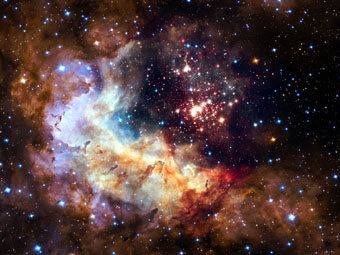
Hubble Birthday: Celestial Fireworks
| published April 24, 2015 |
By Keith H. Roberts Thursday Review contributor
NASA celebrated the Hubble Telescope’s 25th anniversary in style this week, and the Hubble responded in kind with spectacular images of an area known to astronomers as Westerlund 2, in the constellation Carina, a feature of deep space named for Swedish astronomer Bengt Westerlund who discovered the star cluster in the late 1960s. Much of what is seen in this photograph is some 20 thousand light years away from Earth.
Westerlund’s discovery now has a new portrait with this deeply detailed panorama view taken with the Hubble—a dazzling image filled with the light of glittering stars and gas formations roughly two million years old. The dense gaseous areas are actually hatcheries filled with pre-born star formations, infant and toddler stars, and cocoons where thousands of newborns are compressed in stellar dust and gas. The dark red areas represent hatcheries, and the light blue stars are in the foreground, closer to Earth than the much larger formations which create the backdrop.
In all, astronomers estimate that there are some 3000 stars seen in this formation.
NASA officials say that in order to capture this striking image, the Hubble was programmed to filter out much of the gas and dust which would shroud our view of the area around Westerlund 2.
The Hubble was first placed into orbit around the Earth back in 1990, and it became then—and remains now—the largest telescope in space, positioned at an altitude which allows it to see clearly into deep space without the atmospheric distortions and radio interference typical of observatories and telescopes on Earth.
Shortly after the Hubble—which is named for astronomer Edwin Hubble—was deployed and positioned in 1990, scientists back on Earth discovered that a math error had occurred in the grinding and shaping of the telescope’s sensitive lens, and the tiny miscalculation was rendering its image capabilities inadequate. After three years of debate and technical work on the ground, the specially-trained crew of the shuttle Endeavour (mission: STS-61) took a new, correctly ground lens and other replacement electronics into space, making repairs to the Hubble. New computers were also installed, and the Endeavour crew also realigned the Hubble’s orbit. Since then, multiple upgrades and improvements have taken place, including one as recently as 2009. Since then, the orbiting telescope has produced dazzling images and has given astronomers the ability to look deeply into the universe.
For an even closer look at this photograph, follow this link to the NASA webpage devoted to the Hubble’s 25th anniversary:
Click here to view Westerlund in high resolution
Related Thursday Review articles:
Deep Space Versus Lawn Care; Thursday Review staff; Thursday Review; April 7, 2015.
Australia, Seen From Space; Thursday Review staff; Thursday Review; April 8, 2015.
